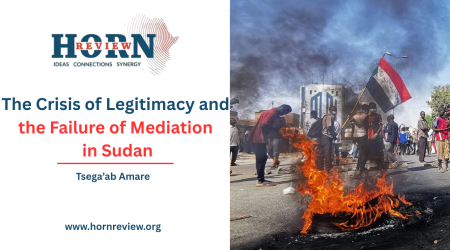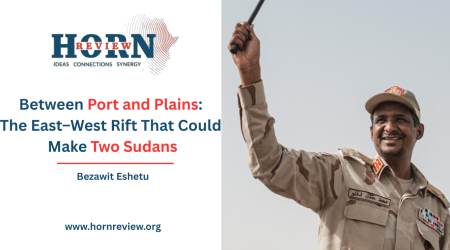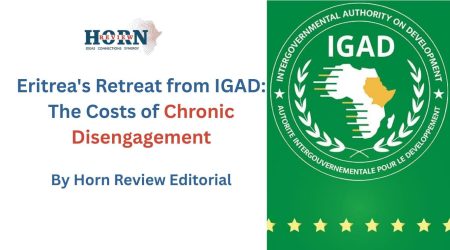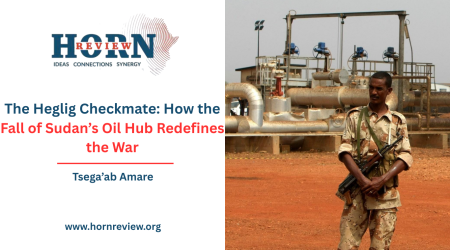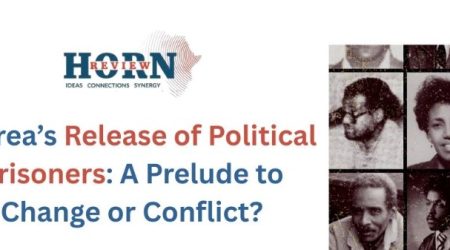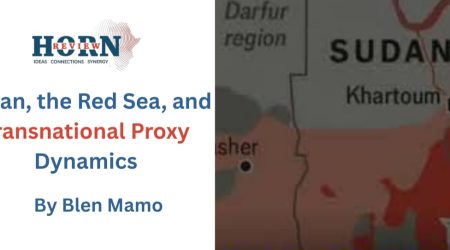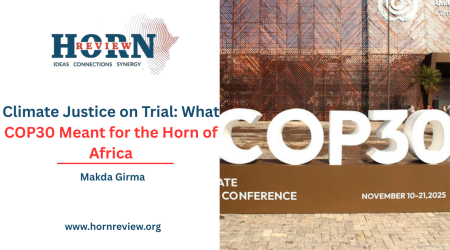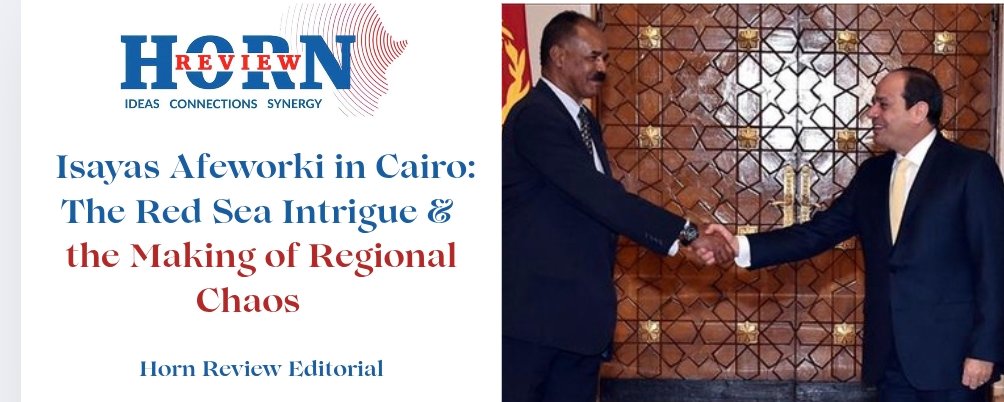
2
Nov
Isayas Afeworki in Cairo: The Red Sea Intrigue & the Making of Regional Chaos
Isaias Afwerki’s recent visit to Cairo for a reported five-day “working trip” has added another layer to the deepening tensions in the Horn of Africa. The visit followed Ethiopia’s Abiy Ahmed’s public call for Eritrea to halt its role as a transit hub for arms – a remark widely interpreted as referring to Asmara’s facilitation of proxy groups within Ethiopia. The timing of Isaias’s journey and its declared agenda on “Red Sea security” underscored the widening rift between Addis Ababa and Asmara, while simultaneously highlighting Egypt’s renewed interest in exploiting that divide for strategic leverage.
In his recent address before the House of Peoples’ Representatives, Abiy Ahmed recounted how relations with Eritrea deteriorated after the 2018 rapprochement. Despite initial optimism, Eritrea repeatedly declined to engage in reciprocal dialogue over trade, infrastructure, and maritime access. Ethiopia’s proposal for cooperative development along the Red Sea corridor was met with silence from Asmara. That stagnation has now given way to open suspicion, creating a vacuum that external actors – especially Egypt – have eagerly sought to fill.
From Cairo’s perspective, the balance between Ethiopia and Eritrea has always been a function of its own Nile-centric anxieties. Historically, Egypt cultivated Eritrean separatist movements such as the ELF and EPLF to curtail Ethiopia’s capacity to harness the Nile. Isaias Afwerki learned early to exploit this perception of Ethiopia as Cairo’s strategic rival. Under his leadership, the relationship evolved into a tactical alignment: Eritrea serving as a convenient counterweight to Ethiopian ambitions, and Egypt as the external sponsor of that balancing act.
The completion of the Grand Ethiopian Renaissance Dam (GERD) fundamentally shifted regional dynamics. To Cairo, the dam represents not merely a technical dispute but an existential threat to its historical command of Nile waters. Ethiopia’s articulation of the “Two Waters Doctrine” – asserting rights over both the Nile Basin and the Red Sea – has amplified Egyptian apprehensions. For Cairo, Ethiopia’s upstream control and its aspiration for maritime access together risk eroding Egypt’s strategic depth. These perceptions have driven Egypt to extend its influence across the Red Sea basin, using both diplomatic and security instruments to maintain leverage.
Within this shifting context, Eritrea’s policies have often appeared to echo Egyptian priorities. Asmara’s reluctance to engage Ethiopia in cooperative frameworks on trade, infrastructure, and Red Sea access mirrors Cairo’s preference for constraining Ethiopia’s regional projection. The convergence has been particularly visible since 2023, when Eritrea’s renewed hostility toward Addis Ababa coincided with Egyptian diplomatic efforts to build a countervailing coalition across the Red Sea littoral. Isaias Afwerki’s subsequent visit to Cairo came just days after Abiy Ahmed’s adress to the parliament, and the fall of al-Fashaga to the RSF, amid reports that both Egypt and Eritrea were providing support to the Sudanese Armed Forces, while Hemedti had only recently issued veiled warnings directed at the two countries.
Following the eclipse of the TPLF’s dominance in 2018 and the subsequent internal rift thereof, Eritrea’s leadership appeared to view the transition in Addis Ababa as an opening to establish leverage over Ethiopian affairs. It was a moment Isaias Afwerki had long awaited since 1993 – when the TPLF consolidated power in Addis Ababa, rendering him and his circle politically irrelevant and isolating him from his long-held ambition to manipulate Ethiopia’s destiny and position hinself as the ultimate arbiter of the region’s fate. Confident in the belief that the nascent Abiy Ahmed’s administration lacked strategic leverage to consolidate power, Isaias sought to position himself as a broker of Ethiopia’s internal balance. Diplomatic observers at the time noted Asmara’s efforts to reassure its few allies, mainly Cairo, that it could “manage” the situation – that Ethiopia merely required space rather than pressure. Yet this calculation proved profoundly mistaken. Abiy’s government demonstrated far greater strategic coherence than anticipated, effectively closing the window for Eritrean manipulation.
The disillusionment that followed produced a reversion to Eritrea’s traditional posture of disruption – a return to covert coordination with regional actors uneasy about Ethiopia’s consolidation of power. Egyptian mediation between Eritrean officials and residual northern Ethiopian movements reflected this renewed convergence, often described as the Tsmdo configuration: a loose network of actors united less by shared vision than by opposition to Addis Ababa’s central authority.
Simultaneously, the regional environment continued to mirror Egypt’s pursuit of strategic depth. In Sudan, the military leadership under General al-Burhan adopted a confrontational stance in the al-Fashaga border zone since 2021 – while tolerating the presence of northern Ethiopian dissidents. Further east, Egypt’s growing security footprint in Somalia – formally under peace-support frameworks – was perceived by regional analysts as part of a broader militarisation trend that risked perpetuating instability. Collectively, these developments reinforced Ethiopia’s sense of encirclement and its conviction that Cairo sought to shape the regional balance of power by sustaining a degree of controlled volatility along Ethiopia’s periphery. Whether by design or consequence, the outcome has been a persistent strategic pressure surrounding Ethiopia’s external borders and maritime approaches.
Isaias Afwerki has publicly expressed enduring hostility toward the Ethiopian state, as evidenced in a VOA interview around the final years of the EPLF’s struggle for secession. He characterized that period as having “given Ethiopia 100 years of homework,” signaling both profound animosity toward the Ethiopian state and an indication that Eritrean secession alone would not satisfy him or his comrades. This mindset provides context for the post-secession cycle of confrontation, war, and recurring tensions – a pattern that continues today, amplified by Eritrea’s instrumentalisation by external actors such as Egypt. Notably, similar rhetoric has occasionally been echoed by elements of the TPLF. Senior officials, including Bereket Semeon, with alleged Eritrean roots, suggested that extended TPLF dominance could permanently reshape Ethiopia’s political landscape, reflecting an approach to power that sought to address internal opposition through generational change. Against this backdrop, Eritrea’s recent Tsmdo project – alligning with Egypt’s proxy actors within Ethiopia – remains a critical destabilizing factor. This network, encompassing remnants of the TPLF and factions of the Amhara-based Fano movement, seeks to weaken Ethiopia’s internal cohesion and erode federal authority.
Further reinforcing Eritrea’s alignment with Egyptian strategic priorities, Egyptian Foreign Minister Badr Abdel Aty, shortly after Isaias’s visit to Cairo, publicly dismissed Ethiopia’s claim to a role in Red Sea governance. This statement not only effectively signals Cairo’s endorsement of Asmara’s position, but also underscores the degree to which Egypt remains a decisive arbiter in the Eritrea-Ethiopia dynamic.
Now, the structural conditions for confrontation between Ethiopia and Eritrea are steadily accumulating. Eritrea remains entangled in multiple internal Ethiopian conflicts, from the northern frontier to the Amhara region, while simultaneously obstructing any cooperative mechanism that could restore Ethiopia’s maritime access. The legacy of the 1993 Eritrean referendum also continues to cast a legal and social shadow, particularly among the Afar communities divided between the two states – many of whom perceive exclusion from their collective right to self-determination. Externally, Ethiopia faces diplomatic constraints to respect Eritrean sovereignty, yet such restraint may erode should regional norms weaken further.
Cairo, for its part, is expected to maintain its characteristic posture of rhetorical and tactical support for Eritrea, rather than overt decisive intervention. Should Asmara interpret Cairo’s tacit approval as conventional backing, the risk of escalation would rise sharply. Eritrea, emboldened by the illusion of external support, might overplay its hand in ways that neither it nor its partners can control. Within this constellation of pressures, the potential for escalation mirrors other modern precedents where unresolved territorial and identity questions – once reopened – proved difficult to contain.
For Addis Ababa, the immediate imperative is diplomatic containment. The government must re-engage Cairo in structured dialogue aimed at isolating Asmara’s destabilizing influence while demonstrating that partnership with Eritrea undermines Egypt’s long-term interests as well as regional stability. Such diplomacy must transcend reactive crisis management to define a sustainable framework governing both Nile Basin and Red Sea engagement.
The broader reality remains clear: Eritrea’s foreign policy, rooted in a zero-sum perception of Ethiopian power, continues to serve as a vector for external agendas rather than autonomous national strategy. Egypt, while adversarial, operates within recognizable strategic logic; Asmara, by contrast, views perpetual tension as the means of asserting relevance. The convergence of these outlooks has produced a volatile alignment that threatens to erode the fragile equilibrium sustaining the Horn of Africa. Preventing renewed confrontation demands not only calling for restraint, but also requires recognizing that unchecked proxy engagement that risks unleashing consequences that neither Cairo nor Asmara can fully contain.
By Horn Review Editorial

